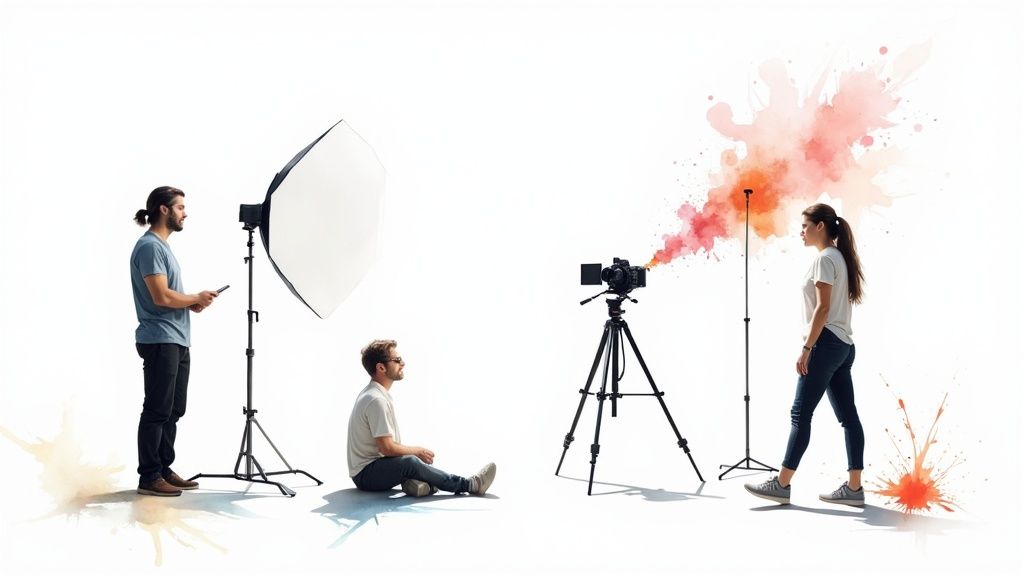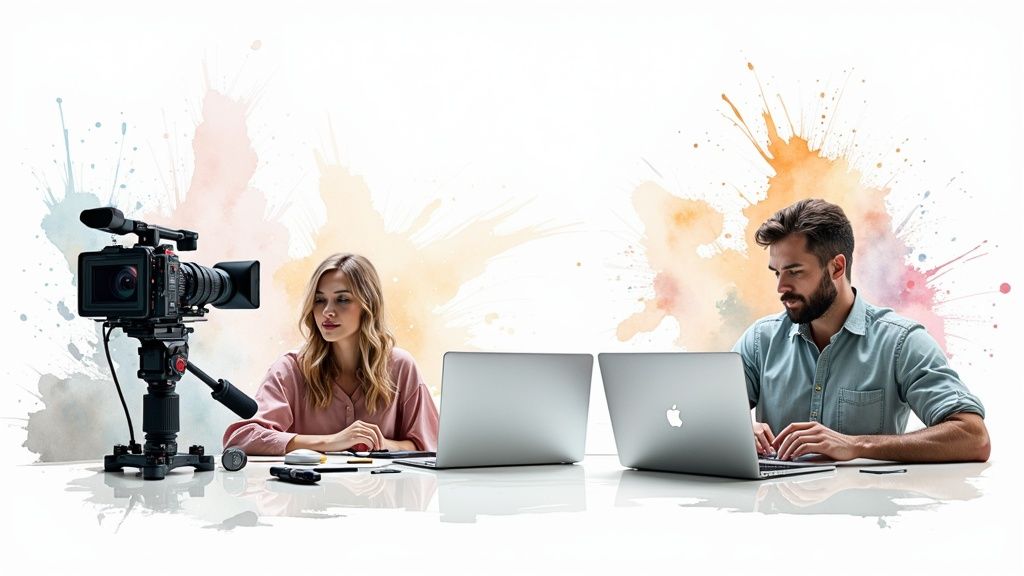In This Article
Subscribe to our newsletter
The Shifting Landscape of Video Content Creation

Creating video content has become a central part of communication. It's no longer a niche activity, but a core strategy. This change is largely due to how audiences now prefer to get information. Think about it: how often do you choose a video over a long article?
This preference for visual learning has fueled the incredible growth of video. It's everywhere, and its impact is undeniable.
Video's Growing Reach
The sheer amount of video being consumed is staggering. In the U.S. alone, live video viewers numbered around 164.6 million in 2024. Globally, online video reaches over 92% of internet users.
Video isn't just popular; it's effective. Viewers retain 95% of a message in video form, compared to just 10% from text. Even with a slight dip, people still watched an average of 17 hours of video per week in 2023. This sustained viewership highlights the power of video marketing. For more statistics, check out this resource: Video Marketing Statistics. Even well-established brands are adapting to this video-centric world.
Why Video Reigns Supreme
Video’s power isn't just about convenience. It's about how our brains work. Visual storytelling connects with our natural ability to process information through sight and sound.
This makes video a powerful tool for building emotional connections with audiences, strengthening brand loyalty, and ultimately, driving conversions. But effective video content requires planning and skill. It's more than just hitting record.
The Power of Authenticity
The type of video content that resonates is also changing. While polished, professional videos are still valuable, there's a growing appetite for authentic, unscripted content. This is partly influenced by social media, where genuine connection is valued.
This shift allows creators with limited budgets to compete. A short, behind-the-scenes clip on a smartphone can be more engaging than an expensive commercial. This accessibility is democratizing video creation, empowering individuals and small businesses.
Embracing the Video Evolution
Video represents a fundamental shift in how we communicate. By understanding the psychology behind its popularity and embracing new creative approaches, businesses and individuals can connect with their audiences in meaningful ways.
This involves a strategic approach to planning, production, distribution, and analysis. Creating effective video content requires a thoughtful approach every step of the way.
Essential Tools for Exceptional Video Content

Creating captivating video content involves more than just hitting record. It requires carefully selecting tools that align with your content goals. This means understanding which investments truly elevate your videos and which can wait. This section explores the essential tools, guiding you toward smart choices for maximum impact without overspending.
Prioritizing Audio Quality for Video Content
Many new creators focus on expensive cameras, neglecting a crucial element: audio. Clear audio is paramount for viewer engagement. A visually stunning video with poor sound is distracting and diminishes the experience. Investing in a good microphone should be your top priority.
A quality microphone often makes a bigger difference than a high-end camera, especially when starting. A crisp lapel microphone or a dedicated shotgun mic drastically improves audio compared to your camera's built-in microphone. This is especially important for interviews or dialogue-heavy content.
Choosing the Right Camera
While audio is king, the camera remains crucial. Choose one that fits your budget and content style. Many viral videos are shot on smartphones, proving you don't need expensive gear to succeed.
As your needs evolve, a dedicated camera offers greater creative control. You can adjust settings like aperture, shutter speed, and ISO for specific visual effects. Consider DSLR cameras or mirrorless cameras for more advanced capabilities.
Lighting and Stability: Enhancing Your Visuals
Two other factors significantly impact video quality: lighting and stability. Proper lighting enhances mood and clarity. This can be achieved with natural light, affordable softbox lights, or even strategically placed lamps.
Stable shots eliminate distracting camera shake, creating a professional look. A tripod is a valuable investment for stability and smooth camera movements. For handheld shots, consider a gimbal stabilizer for a cinematic feel. These affordable tools boost production value, making your videos more engaging.
Software and Editing: Bringing Your Vision to Life
Video editing software brings your footage together. Options range from free basic editors to professional suites like Adobe Premiere Pro. Choosing the right software depends on your editing experience and project complexity.
Beginners can start with user-friendly interfaces, while experienced editors might prefer advanced features. Mastering basic editing techniques like cutting, transitions, and adding text transforms raw footage into compelling stories.
Practical Setups for Different Content Types
Different content needs different setups. Product demonstrations benefit from static angles and good lighting. Interviews benefit from multiple camera angles and high-quality audio. Vlogs thrive on a casual approach, often using a single camera and natural lighting. Understanding these nuances helps optimize your setup for each video type.
To help you visualize the equipment options available at different price points, let's take a look at the following comparison table:
Video Creation Equipment Comparison: A breakdown of essential video equipment options at different budget levels
| Equipment Type | Budget Option (<$200) | Mid-Range ($200-$800) | Professional ($800+) | Key Features to Consider |
|---|---|---|---|---|
| Camera | Smartphone with good camera | Mirrorless or DSLR Camera | Cinema Camera | Resolution, frame rate, autofocus |
| Microphone | Lavalier Microphone | Shotgun Microphone | Condenser Microphone | Polar patterns, sensitivity |
| Lighting | Softbox Lighting Kit | LED Panel Lights | Three-Point Lighting Kit | Color temperature, brightness |
| Stabilization | Tripod | Gimbal Stabilizer | Professional Tripod System | Payload capacity, ease of use |
| Editing Software | Free online editors | Mid-range editing software | Professional editing software | Features, user interface |
This table provides a starting point for choosing your video creation tools. Remember to prioritize your needs and budget when making your selections.
By carefully selecting tools and understanding their purpose, you create compelling video content that engages your audience and achieves your goals. Strategic investments in essential equipment significantly impact your videos' quality and effectiveness.
Crafting Video Content That Resonates and Converts

Creating video content that truly captivates viewers involves a deeper process than simply hitting record. It demands a keen understanding of your audience, a well-defined strategy, and a structured approach to development. This section explores the methods successful creators use to craft videos that not only resonate with their viewers but also effectively drive conversions.
Understanding Your Audience's Needs
The foundation of compelling video content lies in understanding the psychological triggers that motivate your audience. What are their pain points, their aspirations, and their core values? Your videos should directly address these needs.
For example, if you're targeting busy professionals, your content might focus on time management techniques or productivity hacks. This targeted approach ensures relevance and value for the viewers you aim to reach.
Consider the emotional impact you want to create. Do you aim to inspire, educate, or entertain? Understanding the desired emotional response will shape your content and delivery style, fostering a stronger connection with your viewers.
Structuring Videos for Maximum Impact
The structure of your videos plays a vital role in maintaining viewer engagement. A strong hook in the first few seconds is essential. This could be a thought-provoking question, a startling statistic, or a visually captivating scene. This hook determines whether viewers stay tuned or click away.
The remainder of your video should deliver on the initial promise. Offer valuable insights, share a compelling narrative, or present practical solutions to your audience's challenges. This value-driven approach ensures viewers gain something tangible from their time spent watching.
Balancing Content Elements for Optimal Engagement
Successful video content often blends educational, inspirational, and promotional elements. However, finding the right balance is crucial. Too much promotion can feel intrusive, while solely educational or inspirational content may not effectively drive conversions.
A balanced approach educates and inspires while subtly guiding viewers toward your desired action, whether it's a purchase, newsletter signup, or website visit. For additional strategies, check out this resource: Video Content Marketing Strategies That Convert. This ensures value while achieving marketing objectives.
Content Planning and Creative Momentum
Consistent, high-quality video output requires meticulous planning. A content calendar aligned with your overall marketing strategy ensures a cohesive brand message. This calendar also helps maintain creative momentum and anticipate audience needs.
By 2025, 3.78 billion people are projected to consume digital video content, with 42.6% viewing on mobile phones. Find more statistics here. This emphasizes the need to adapt to evolving viewer habits. Tools like a Lyric Video Maker can be invaluable for specific content creation needs.
Planning ahead allows you to align content with seasonal trends or upcoming events. By implementing these frameworks, you can create video content that resonates with your target audience, drives meaningful engagement, and ultimately converts viewers into loyal customers.
Production Techniques That Command Attention

Creating captivating video content doesn't always require top-of-the-line equipment. Often, it's about making smart production choices that elevate the perceived value. This involves focusing on key elements like composition, audio quality, directing, and problem-solving during filming.
Mastering Visual Storytelling Through Composition
Composition refers to how elements are arranged within the frame. Leading creators often utilize simple principles, like the rule of thirds, to create visually balanced and appealing scenes. This involves visualizing a 3x3 grid overlaid on your frame and positioning key subjects along these lines or at their intersections.
This technique adds dynamism and visual interest, making shots more engaging. Headroom, the space between the subject's head and the top of the frame, is another crucial element. Too much headroom can make the subject seem lost, while too little can feel claustrophobic. Finding the right balance is essential for a polished look.
Achieving Professional Audio in Any Environment
High-quality audio is paramount. Even the most visually stunning shots lose their impact if the audio is subpar. Top creators prioritize audio, understanding its significant impact on viewer experience.
Poor audio is often more distracting than poor visuals. Investing in good microphones is a crucial first step. This includes selecting the right type of microphone for the scenario: a lavalier microphone for interviews or a shotgun microphone for noisy environments. Techniques like using wind protection outdoors and monitoring audio levels during filming significantly enhance the final product.
Directing for Authenticity and Engagement
When working with non-actors, direction becomes even more critical. The objective is to capture authentic performances that resonate with the audience. This often involves creating a comfortable filming atmosphere.
Simple strategies, such as providing clear instructions, offering positive feedback, and allowing multiple takes, can make a world of difference. Encouraging natural expressions and reactions often yields more compelling results than rigidly scripted performances. Open-ended questions can also lead to more engaging and insightful responses.
Overcoming Common Filming Challenges
Filming rarely proceeds without a hitch. Unexpected lighting changes, location limitations, and equipment malfunctions are common occurrences. Successful creators are defined by their adaptability and problem-solving skills.
For instance, in dimly lit spaces, they might use reflectors or adjust camera settings to optimize available light. In a restricted location, they might find creative ways to frame shots within the given confines. This resourcefulness allows them to capture quality footage despite limitations. For more insights on creating effective video ads, check out this helpful guide: How to Create Video Ads That Convert.
Streamlining the Filming Process
Efficient filming goes beyond capturing the intended shots. It also involves providing the editor with ample footage to work with. This is where the concept of coverage comes into play.
Coverage entails filming a scene from various angles and distances, giving the editor flexibility during post-production. Establishing shots, cutaways, and insert shots add depth and context to the narrative, enhancing the final edit.
Production Checklist for Success
A checklist can be invaluable for ensuring a smooth and efficient filming process. The table below outlines key tasks, common mistakes, and pro tips for each production stage.
Before diving into the table, it's important to understand that each stage plays a vital role in the overall success of your video project. From pre-production planning to post-production polishing, attention to detail is key.
| Production Stage | Key Tasks | Common Mistakes | Pro Tips |
|---|---|---|---|
| Pre-Production | Location scouting, scriptwriting, creating a shot list | Not allocating enough time | Develop a detailed schedule and stick to it. |
| Production | Capturing footage, monitoring audio, directing talent | Neglecting audio quality | Always use headphones to monitor sound. |
| Post-Production | Editing, color correction, sound mixing | Over-editing, inconsistent visuals | Keep the edit concise and maintain visual consistency. |
This checklist offers a practical framework for navigating each stage of video production. By addressing these key aspects, you can minimize potential issues and maximize your chances of creating a high-quality final product.
By mastering these fundamental production techniques, you can elevate your video content, commanding the attention your videos deserve. This involves understanding the visual and auditory language of film and utilizing it to tell your story effectively.
Editing Strategies That Keep Viewers Hooked
Creating compelling video content goes beyond simply shooting and assembling clips. It requires a keen understanding of editing techniques that capture and maintain viewer attention from start to finish. This involves not only technical proficiency but also a grasp of the psychological principles that influence how viewers perceive and react to your videos.
The Psychology of Engagement: Creating Anticipation and Preventing Dropoff
Effective editing uses psychological principles to keep viewers engaged. Creating anticipation is a key technique. Just as a skilled storyteller builds suspense, video editors use tools like quick cuts, close-ups, and music to generate excitement for what's next. This keeps viewers from losing interest and clicking away.
Pacing is also critical. Information should be delivered at a speed that keeps viewers absorbed but not overwhelmed. Varying shot lengths and using transitions strategically prevents the video from becoming monotonous. Think of it like the rhythm and flow of a captivating song.
Visual and Audio Cues: Reinforcing Key Messages
Visual and audio cues are effective tools for emphasizing key messages. A subtle sound effect can highlight an important point, while a change in music can signal a shift in mood or topic. These cues work subconsciously to enhance viewer understanding and retention.
Graphics, text overlays, and animations can further reinforce key takeaways and make them more memorable. However, use these elements sparingly. Overusing visual effects can be distracting, detracting from the core message.
Editing Frameworks: Tailoring to Different Objectives
Different videos require different editing approaches. A brand storytelling video might employ a slower pace and emphasize emotional connection. An educational video, on the other hand, benefits from a clear, concise style with helpful visuals. Understanding these differences allows creators to tailor their editing to each video's objective.
A fast-paced edit with jump cuts might suit a dynamic travel vlog but be inappropriate for a serious documentary. Knowing your audience and the purpose of your video is crucial for selecting the right editing style.
Building a Brand Identity Through Editing
A consistent editing style reinforces brand identity. Just as a company has a logo and color scheme, a distinct editing approach creates a unique look and feel for your videos. This might involve specific transitions, music, or graphics that become associated with your brand.
Over time, this consistency becomes a part of your brand's DNA, fostering familiarity and trust with your audience. Viewers start to connect your editing style with the quality they expect from your content. This strengthens loyalty and builds a stronger bond with your brand.
Encouraging Action and Incorporating Graphics
Effective video content aims to encourage viewer action, whether visiting a website or making a purchase. Editors can use techniques like call-to-actions within the video and prominent links in the description to guide viewers toward these actions.
Graphics enhance engagement and comprehension, but they should never overshadow the main message. Simple, clean graphics that complement the narrative are more effective than flashy animations that clutter the screen. The goal is to enhance, not overwhelm, the viewer experience.
Platform-Specific Optimization for Maximum Reach
Creating video content is only half the journey. The other half involves ensuring it connects with the intended audience. This requires a platform-specific strategy. Many creators mistakenly treat all platforms equally, overlooking the unique algorithms, audience expectations, and optimal content formats that distinguish each one.
Tailoring Your Content for Each Platform
Consider this analogy: you wouldn't wear a swimsuit to a board meeting or a business suit to the beach. Similarly, a video that performs well on TikTok might not resonate on LinkedIn. Grasping these nuances is essential for maximizing your reach.
Successful video creators develop tailored strategies for each platform. For instance, YouTube viewers often anticipate longer, in-depth tutorials, while Instagram users tend to favor short, visually captivating clips. Adapting your content accordingly is crucial for capturing and maintaining viewer interest.
Optimizing Titles, Thumbnails, and Metadata
Titles, thumbnails, and metadata act as gatekeepers to your content. They are a viewer's first impression, influencing whether they click or scroll past. On platforms like YouTube, keyword-rich titles and compelling thumbnails are vital for attracting clicks and enhancing search visibility.
Think of your thumbnail as a miniature movie poster. It should be visually attractive, accurately reflect your content, and entice viewers to click. Metadata, the information accompanying your video (such as tags and descriptions), helps search engines understand your content, boosting discoverability. For additional guidance, explore our guide on How to Master Social Media Video Best Practices.
Adapting Content, Not Recreating It
Generating unique content for every platform can be incredibly time-consuming. Savvy creators adapt existing content instead of starting from scratch. A long-form YouTube video can be repurposed into shorter segments for Instagram or TikTok, maximizing your reach efficiently.
This could involve highlighting key takeaways, creating engaging excerpts, or incorporating platform-specific elements like music and text overlays. This multi-platform approach broadens your audience and reinforces your message across various channels.
Identifying Key Performance Metrics
Not all metrics hold equal value. Vanity metrics, like view count alone, don't necessarily indicate business success. Effective creators concentrate on metrics aligned with their objectives. If your goal is to drive sales, conversions and click-through rates become more significant than mere views.
For instance, if you aim to direct traffic to your website, tracking click-through rates from links within your video descriptions becomes paramount. Understanding which metrics truly matter enables strategic optimization and achieving meaningful outcomes.
Counterintuitive Posting Strategies and Community Building
Sometimes, less is more. Excessive posting can overwhelm your audience and dilute your message. Strategic posting schedules, optimized for each platform's algorithm, can actually increase reach.
This might involve analyzing peak engagement times and adjusting your posting frequency accordingly. Cultivating a strong community around your content is another crucial factor. Engaging with comments, addressing questions, and fostering a sense of belonging can convert passive viewers into active advocates. Video content creation also significantly impacts marketing. By 2025, video marketing is projected to constitute 82% of consumer internet traffic, with video streaming comprising approximately 91%. Videos are potent persuasive tools, with 84% of consumers reporting that a video influenced their purchasing decision. For further insights, consult these statistics: 2025 Video Marketing Statistics. This underscores the importance of video in expanding brand visibility and driving sales.
By adopting a platform-specific approach, you can ensure your efforts reach their full potential. This targeted strategy transforms your videos from simple content into powerful tools for connection, engagement, and conversion.
Transforming Analytics Into Strategic Advantage
Analyzing data is crucial for improving your video content. It's not just about vanity metrics like view counts. Successful video creators use analytics to gain actionable insights, refining their approach and staying ahead of the competition. This involves identifying patterns, developing testing frameworks, and building feedback loops for continuous improvement.
Identifying Patterns in Viewer Behavior
Viewer data is like a treasure map. Hidden within are clues to what resonates with your audience. Watch time, for instance, reveals which parts of your videos hold attention and where viewers lose interest. This information can guide future content creation, allowing you to focus on topics and formats that genuinely engage.
Audience demographics provide another layer of understanding. Knowing the age, location, and interests of your viewers allows for more targeted content. Imagine discovering a significant portion of your audience is interested in a specific niche you hadn't considered before. This data reveals a valuable opportunity.
Developing Testing Frameworks for Optimization
Creating video content is iterative. A/B testing different titles, thumbnails, and even introductions can reveal what performs best. This involves creating two versions of an element, showing each to a segment of your audience, and analyzing the results. A thumbnail with a face might perform better than one with just text. This data informs future thumbnail design.
This systematic approach isolates variables, allowing you to pinpoint what resonates with your audience and optimize accordingly. It's like a scientific experiment to discover the most effective formula for engagement.
Building Feedback Loops for Continuous Improvement
Direct audience feedback is invaluable. Comments sections, polls, and Q&A sessions provide direct insight into what viewers appreciate and want more of. If viewers consistently request content on a specific topic, this feedback directly informs your content calendar.
This creates a feedback loop, where audience input shapes future content. This iterative process keeps your videos relevant, valuable, and engaging for your target viewers.
Interpreting Seemingly Contradictory Signals
Sometimes, data can appear conflicting. A video might have high view counts but low watch time. This suggests the title and thumbnail attracted clicks, but the content itself didn't hold attention. This requires deeper analysis.
Top creators understand how to interpret these nuances. They look beyond surface metrics to understand the underlying story. They might revisit the video's pacing, content, or call to action to identify areas for improvement.
Balancing Creative Instincts With Data-Driven Decisions
Data shouldn't stifle creativity. While analytics provide valuable insights, it's important to balance them with your creative vision. Don't let data dictate every choice. Sometimes, following your intuition and experimenting can lead to unexpected success.
Think of data as a compass, guiding you, while your creative instincts provide the fuel for innovation. Successful creators find synergy between these two forces.
Identifying Early Indicators of Shifting Audience Preferences
Audience preferences are constantly evolving. Staying ahead of these shifts is crucial for long-term success. Analyzing data over time reveals emerging trends. Perhaps you notice growing interest in a new topic or declining engagement with a particular format. These are valuable insights.
Recognizing these early indicators allows you to adapt proactively, staying relevant and engaging your audience with fresh content.
Identifying Key Performance Indicators for Long-Term Success
Differentiating between vanity metrics and meaningful metrics is crucial. While high view counts might seem impressive, they don't always indicate long-term success. Metrics like audience retention, conversion rates, and engagement levels are more indicative of lasting impact.
Building dashboards that track these key performance indicators lets you focus on the metrics that matter. This helps you make data-driven decisions that contribute to sustainable growth and long-term success.
Aeon, the video creation platform, empowers publishers to transform their content into engaging video formats. Learn more about Aeon and its capabilities for your video content strategy.






.jpg)